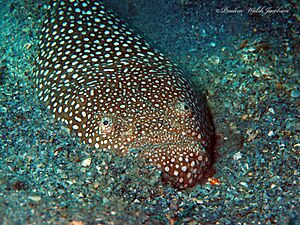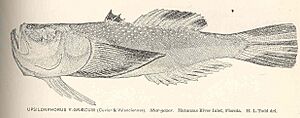Southern stargazer facts for kids
Quick facts for kids Southern stargazer |
|
|---|---|
 |
|
| Conservation status | |
| Scientific classification | |
| Synonyms | |
|
Uranoscopus y-graecum Cuvier, 1829 |
The southern stargazer (Astroscopus y-graecum) is a fascinating fish that lives in the ocean. It belongs to a family of fish called Uranoscopidae. These unique fish are originally from the United States.
Contents
Amazing Features of the Southern Stargazer
Southern stargazers can grow up to about 44 centimeters (17 inches) long. They have a brownish body covered with small white spots. Their side fins, called pectoral fins, have black and white lines. Their tails have three black or brown stripes.
These fish use their strong pectoral fins to dig. They bury themselves in the sand or mud on the ocean floor. When they hide, only their eyes, nostrils, and most of their mouth stick out. This helps them stay hidden from predators and surprise their prey.
To breathe while buried, they take in water through their nostrils. These nostrils have special comb-shaped fringes. These fringes keep sand out. Their mouths also have these fringes.
Southern stargazers do not have scales on the top of their heads. But the rest of their body, even part of their tail, is covered in scales. Their eyes can stick out a little from their heads. This helps them see above the sand when they are buried.
One of the most amazing things about them is their electric organ. This organ is in a pouch behind their eyes. They can create an electric current as strong as 50 volts! They mostly use this shock to protect themselves. It is not usually used to catch food. The strength of their electric shock can change depending on how warm the water is.
What Southern Stargazers Eat
Southern stargazers are hunters. They are very patient! They hide under the sand with only their heads showing. When a smaller fish swims close by, the stargazer quickly pops out and catches it.
Where Southern Stargazers Live
These fish live on the ocean floor. They are often found near reefs. They spend most of their lives close to the shore. You can find stargazers in water up to 70 meters (230 feet) deep. They like areas with sandy, silty, or soft rubble bottoms.
Reproduction and Life Cycle
Southern stargazers lay their eggs in late spring and early summer. They lay their eggs on the ocean bottom. These tiny, clear eggs slowly float up to the surface of the water.
When the eggs hatch, the baby fish are called larvae. They are also clear and live floating in the water. For a while, they eat from a yolk sac, which is like a lunchbox attached to them. Once they grow to about 6 to 7 millimeters (0.2 to 0.3 inches), they start eating other tiny larvae.
When they reach about 12 to 15 millimeters (0.5 to 0.6 inches) long, their electric organs start to form. At this point, they begin to swim down to the ocean floor. They become young fish, called juveniles.
Young stargazers often move closer to shore, into sandy bays. They might stay there for many years. This is where they grow and develop the features of adult stargazers. For example, their eyes move from the side of their head to the top. Once they are about 30 centimeters (12 inches) long, they move offshore and become adults.
Where You Can Find Them
The southern stargazer lives in the western Atlantic Ocean. You can find them from North Carolina, south along the coast to the Gulf of Mexico, and down to the Yucatán Peninsula. They also live along the Caribbean coasts of Central and South America, from Mexico to Rio de Janeiro. However, they are not found in the West Indies.
What's in a Name?
The name Astroscopus comes from Latin. It means "one who aims at the stars." This is a perfect name for a fish that looks up from the sand!




